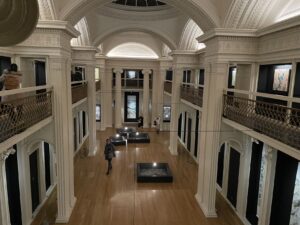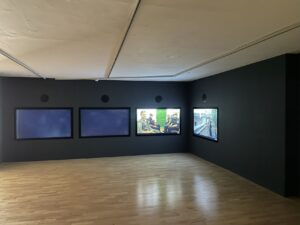After a short tour of Talbot Rice Gallery and a review of its space and design, this week’s session was given by curator James Clegg, who enthusiastically explained much about curation, how to prepare a curatorial theme, choose artists and think about what is required for a show in a contextual way.
I thought it was a great opportunity to get up close and personal to rethink the perspective of an exhibition from a gallery as special as Talbot Rice Gallery, which opened in 1975 and is located in the corner of Edinburgh University’s Old College in the centre of Edinburgh. Talbot Rice collaborates with both local and international artists, holding three to four exhibitions a year and running a unique artist-in-residence programme. In recent exhibitions it has become closer to the Chinese artist Zhijie Qiu and the whole perspective of the exhibition has gradually revealed a modesty towards the contemporary art narrative of the East. At the same time, it is a very good way to think about one’s own exhibitions by starting with Talbot Rice Gallery, where the construction of the exhibition is tangible and realistic in a concrete context, which is much clearer than a mere programme.
Talbot Rice Gallery combines classical and contemporary architecture to perfection, maximising the space available to it, making significant cost savings in constructing new spaces, while retaining differentiated spaces that are subtly adapted to the possibility of displaying more artworks. But at the same time, the whole gallery has some problems, because the space is small, so it is strange for the viewer to be ‘interrupted’ several times, for example, when a door or a corridor suddenly appears around the corner, without a certain time buffer and a gentle guidance, so for the viewer, should they enter this entrance or go elsewhere?
When planning an exhibition, the curator’s primary concern is to create an environment that allows the artwork to reach its maximum potential. Curatorial planning can be an extension of the artwork, although this is often typical of conceptual artworks and is at the discretion of the artist. Artworks can reshape a space, but rarely does the artwork ‘speak for itself’. It is therefore of utmost importance that the spatial context is integrated into the artwork before a new environment is constructed. Considerations in public spaces can be boring, and health and safety awareness needs to be taken into account. Will there be enough space to leave in the event of a fire? (I think Talbot Rice Gallery might have some hidden dangers if faced with a large volume of people) and also consider planning space to protect the artwork; the less space there is to move around, the greater the chance of knocking objects around. (If a larger installation were to be organised in the Georgian gallery section there would obviously be very little room to move around, with only one person allowed to pass on either side of the aisle)
Ultimately, however, there is no denying that the Talbot Rice Gallery is a good window for cultural exchange at school level, and James Clegg suggested that we think about what we want to do with the exhibition here, and how to organise, curate and calculate budgets from there.




One of the performance artists I was interested in before, Gina Pane, if I were to organise her work, I think I could divide it up by the type of work in her life and the three spaces in the gallery, summarising the three periods of Pane’s artistic development 1968-1971, and 1970-1980, and after the 1980s “The relationship between the body and the world”. When I consider space, I think first of light. So in the white space at the entrance, which is where the viewer first enters, I will put in documentary photography such as Displaced Stones (1968), Protected Earth (1968-1970) and Enfoncement d’un rayon de soleil (1969). This is the brightest space and the perspective through which the first works developed to reflect on “placing the body in nature”. The second part of the exhibition is then placed on the first floor, where the section on “active groups in public” is exhibited with images, props and key photographs. This is a relatively small location with three display spaces, which can be divided somewhat according to the theme and content. At the end, the Georgian gallery is the most extensive section. This is where the whole exhibition culminates in a more radical and controversial discussion of the relationship between the body and the world in Gina’s work from this period, and on the pavilion, as one exits this gallery, the viewer is about to exit the same way.


Leave a Reply